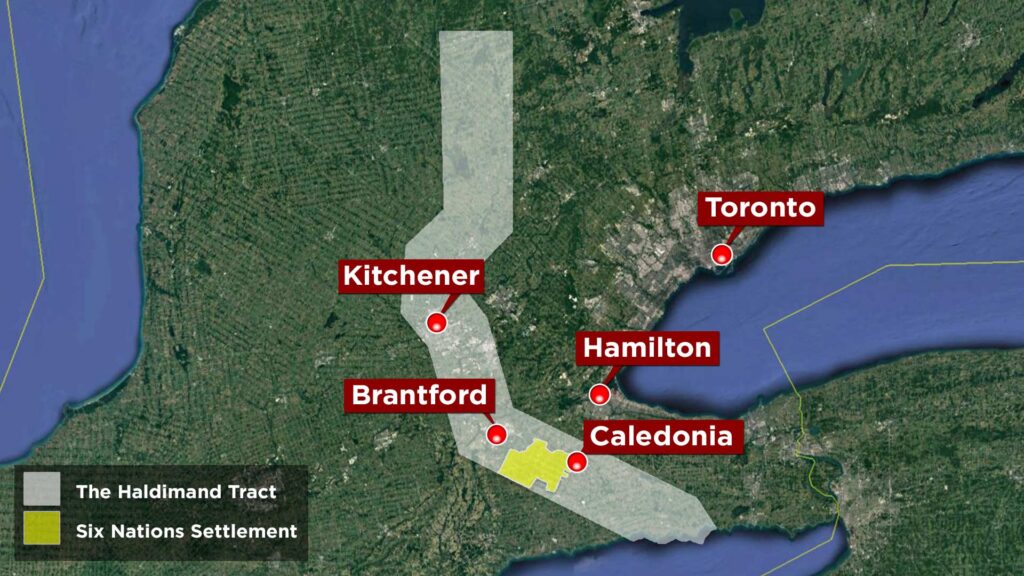
The Haudenosaunee Confederacy Chiefs Council says they are declaring a moratorium on all development along the Haldimand Tract — unless those developers make financial accommodations to the hereditary chiefs through the Haudenosaunee Development Institute (HDI).
A handful of hereditary chiefs and their supporters called in local and national press to make the declaration on Tuesday morning in front of the Onondaga Longhouse.
“Developers, they need to stop digging in our land and to come forward now and do the process that’s right. There’s no more taking our lands. This stuff has to stop,” said hereditary chief Roger Silversmith.
He said that developers must go through the HDI, and the hereditary chiefs properly compensated for all development along the Haldimand Tract.
“The Haudenosaunee intend to exercise our jurisdiction over our lands and waters in a way that maintains the delicate balance between Creation and humans, focusing on sustainability and responsiveness to climate change to protect waterways and ecologically sensitive areas,” said HCCC in a statement.
The declaration highlights the ongoing tug-of-war between Six Nations hereditary chiefs, the community’s 100 year-old system of elected leadership, or the Mohawk Nation of Grand River Country — duking out who has true jurisdiction over the community’s land rights.
Those divisions were once again thrust into the spotlight this past year when a small group of Six Nations people stopped construction of the McKenzie Meadows housing development in Caledonia, in a land occupation now dubbed Land Back Lane.
The project was approved by the elected council after community consultations revealed no substantial opposition. The elected council was compensated financially and a parcel of land donated back to the community as an accommodation.
The community’s hereditary leaders are now saying no development can proceed along the Haldimand Tract without going through HDI and making financial accommodations for the hereditary chiefs.
A similar attempt to assert jurisdiction took place in the late spring of 2019, when HDI supporters attempted to forcibly halt the completion of the Niagara Reinforcement Line, a hydro line project that compensated the elected council and not HDI.
In that situation — HDI entered into talks with Hydro One — saying they would call off the protesters on the condition that the energy company tear up its’ accommodation agreement with the elected system and enter into an exclusive compensation agreement with the hereditary chiefs.
This is the latest declaration of jurisdiction in an ongoing story that dates back to the federal government, deposing hereditary leadership in 1924.
In 1923, following decades of community uproar about mismanagement of funds and abuse of power by hereditary chiefs, the federal government conducted an inquiry into the business of managing the reserve.
Community members advocated to the federal government for help installing an elected system.
The 1923, a Six Nations inquiry, led by the federal government, found that the hereditary leadership did not manage the community fairly. As a result, Canada removed the hereditary system of installing leaders and instead transitioned the community to an elected band council system under the Indian Act.
In recent history, HCCC has made efforts to build it’s own administrative functions to assert their belief that they are the sole and rightful holders to land rights along the Haldimand Tract.
They created HDI, a development company that has routinely competed with the elected council for financial compensation in exchange for acquiring hereditary chiefs consent for development along the tract — something they say can’t be properly granted by the elected leadership.
The Haldimand Treaty of October 25, 1784 set aside approximately 950,000 acres along the Grand River for “the Mohawks and such others”. The HCCC says that treaty gives their organization exclusive land rights over six miles on either side of the entire span of the Grand River.
Today, the size of the reserve is approximately 5% of the lands described in the original proclamation. A total of 38 municipalities exist along the Haldimand Tract.
“The development – it’s uncontrolled,” said HCCC Secretary Leroy Hill at Tuesday’s press conference. “It’s not being resolved in a just manner. They just keep issuing permits on unresolved lands and in the meantime we’re losing our ability to expand for our families. The leaders have been mulling this over for awhile.”
Cayuga Chief Roger Silversmith said, “Land is a birthright. With these land rights come specific responsibilities. Land is envisioned as a dish with one spoon. We can all take from the land…but we must ensure the land remains healthy enough to provide for the coming generations.”
“We understand that we share these lands with our Allies and we all agree to uphold the agreements between our people to live in peace, friendship and trust,” the HCCC said in a statement. “Our vision for the future is self-determined, based in our inherent right to protect our lands for future generations of Haudenosaunee children.”








